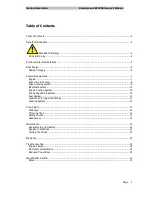
Marine Revolution
Smartwave SW 4200 Owner’s Manual
Page
4
4) speed;
5) rapid acceleration;
6) transition from displacement to planing mode;
7) sea conditions;
8) rain and spray;
9) darkness and fog;
10) interior lights;
11) position of tops and curtains;
12) persons or movable gear in the operator’s field of vision.
b) The International Regulations for Preventing Collisions at Sea (COLREG) and the rules of the road
require that a proper lookout be maintained at all times and observance of right of way be respected.
Observance of these rules is essential.
Boat Loading and Trim
It is imperative the operator uses common sense when loading the boat/seating
crew to achieve a safe and level trim. The positioning of the seats and capacity does not imply in any
way that is safe to use the seating provided in every instance. Particular care should be taken when
positioning weight at the stern or bow of the boat is this may lead to swamping or dangerous handling
characteristics.
Man-overboard Prevention and Recovery (BS EN ISO 15085)
Re entry at the stern of the boat is recommended if the vessel is in the swamped condition
NOTE:
This boat does not require any specific device to re-board, due to its characteristics.
The boat, in light craft condition according to ISO 8666, has a minimum freeboard less than
500 mm, so needs only one handhold, suitably located to allow re-boarding, with consideration of
the boat's stability.
The recommended re-boarding method was demonstrated during the stability tests. Pictures are
below:
Drink and drugs
Be sensible about drinking alcohol, as it will impair your judgement. Consider it as irresponsible for a
skipper and crew to be in charge of a powerboat under the influence of alcohol as it is for the driver of
a car. Beware of the side effects of any medication which may impair judgement and reduce the
effectiveness of the person concerned.

































